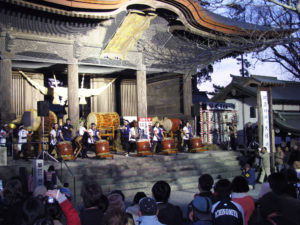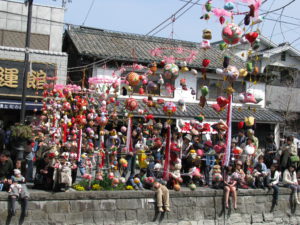Bayside Place Hakata
Bayside Place Hakata is a shopping mall and entertainment complex adjoining
the Hakata Port Passenger Terminal. Beautiful view from the Bayside tower
observatory place can be enjoyed, such as overview of Hakata Port as well as
Fukuoka-city including Fukuoka boat race stadium.
 |
 |
 |
February 04, 2025
Tochoji temple, in Fukuoka-city
You first visit Fukuoka, we really recommend Tochoji temple for feeling Japanese culture.
The largest seated wooden image of Buddha in Japan. Tochoji temple was founded in
806 by Kobo-daishi Kukai and it is the oldest temple of the Shingon sect in Japan that
Kobo-daishi set up.
 |
 |
 |
February 03, 2025
Today’s lunch at Itoshima
We conducted the environment tour of Itoshima for Kitakyushu citizen group and took
lunch at authentic Seafood restaurant, Isonoya. Enjoyed Special seafood dish used
fresh fishes caught in the Genkai Sea.
 |
 |
 |
February 02, 2025
Hiburi-shinji, at Aso Shrine
Hiburi-shinji is the annual festival held at Aso Shrine in Aso, Kumamoto-prefecture.
Hiburi-shinji is a Shinto ritual that signifies the wedding ceremony of the gods.
A ring of flames swinging heroically colors the Shrine at night, and the whole area
is enveloped in a fantastical atmosphere. After Hiburi-shinji end, spring comes to Aso.
 |
 |
 |
February 01, 2025
Yanagawa Sagemon Festival
The festival is held from February 11 through April 3 in Yanagawa. Hina dolls are displayed
by families with girls to pray for safe growth of their children, in Yanagawa, in addition to
Hina dolls, colourful “Sagemon” are displayed.
 |
 |
 |
January 31, 2025
Kyokusui-no-en Dazaifu, March 2
The festival is held at Dazaifu Tenmangu Shrine on first Sunday of March, a purification ceremony
on a winding stream, is performed by ladies and gentlemen in a ceremonial court robe under the
plum blossoms in full-bloom.
 |
 |
 |
January 30, 2025
Hisayama Country Club, in Fukuoka-prefecture
This is our recommended course located near the center of Fukuoka-city. This is one
of the historical golf courses in Fukuoka-prefecture, constructed in 1964. It was
designed and supervised by three famous professional golfers, Torakichi Nakamura,
Takehito Fujii, and Yoshimasa Fujii. So far, many professional tournaments were held.
 |
 |
 |
January 29, 2025
Michino-eki, enjoy shopping for local items
Michino-eki means Road Station in Japan and provides places for travelers to rest,
they are intended to promote local tourism and trade. There are local shops such as
agricultural products (fruits, vegetables, flowers etc. ) , seafood, snacks, souvenirs
and other goods. And also, some Michino-eki have restaurants.
You can enjoy the shopping for local items.
 |
 |
 |
January 28, 2025
Yoshii Hina doll Festival
Yoshii is located in Ukiha, Fukuoka-prefecture. Hina doll Festival is held from February
11 through March 20. Main Hina dolls are displayed at Shirakabe Avenue district, where
the river is lined by attractive former warehouses, all with traditional wood and white
plaster exteriors. Please visit Yoshii enjoying Japanese Cultural experience.
 |
 |
 |
January 27, 2025
Restaurant renovated from a primary school gymnasium
Miyawaka Kitchen Restaurant is located in Miyawaka-city between Fukuoka-city and
Kitakyushu-city, and the Restaurant offers local ingredients from Fukuoka, Miyawaka,
and Kyushu, along with rare and expensive ingredients from around the world.
Enjoy carefully selected domestic aged meat, seasonal pasta made with fresh noodles,
and pizza made with rice flour.
 |
 |
 |
January 26, 2025
